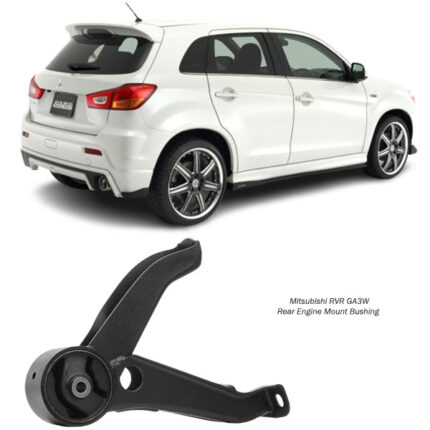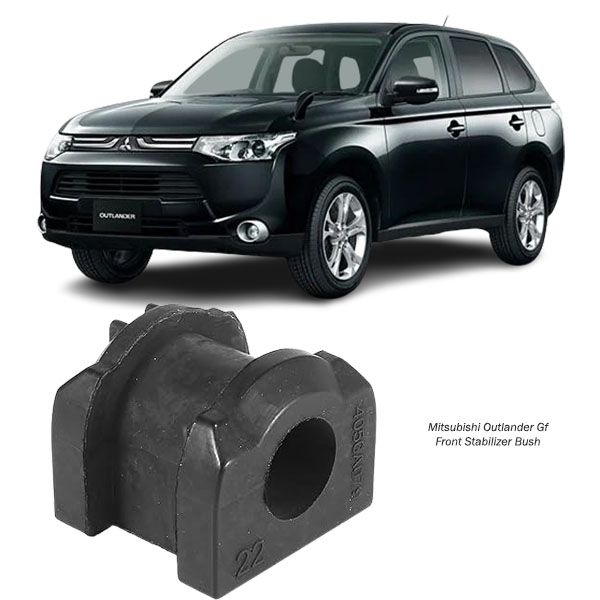-17%
Get Mitsubishi Outlander GF Front Stabilizer Bush 4056A079 in Kenya
A front stabilizer bush (also known as an anti-roll bar bush or sway bar bushing) is a small yet crucial component of a vehicle’s suspension system. It helps reduce body roll during cornering, ensuring better handling and ride stability.
🔧 Think of it as a cushion that holds the stabilizer bar in place while allowing controlled movement.
Why is it Important? 🏁
✔️ Absorbs vibrations and reduces noise.
✔️ Keeps the stabilizer bar in position.
✔️ Improves handling and steering response.
✔️ Enhances ride comfort by reducing body roll.
✔️ Prevents premature wear of suspension parts.
2. Understanding the Stabilizer Bar and Bushes 🏗️
The stabilizer bar (sway bar/anti-roll bar) is a metal rod that connects the left and right wheels through the suspension. It prevents excessive body roll when the car turns.
🔩 The stabilizer bushes are rubber or polyurethane mounts that secure the bar to the vehicle’s frame while allowing limited movement.
Key Functions of Stabilizer Bushes 🛑
- Act as a cushion between the stabilizer bar and chassis.
- Allow controlled movement of the stabilizer bar.
- Minimize noise, vibration, and harshness (NVH).
3. Types of Front Stabilizer Bushes 🔍
Different vehicles and driving conditions require different types of stabilizer bushes.
1. Rubber Bushes 🛠️
✔️ Most commonly used in factory (OEM) setups.
✔️ Soft and flexible, providing a comfortable ride.
✔️ Absorbs vibrations and reduces noise.
❌ Wears out faster over time.
2. Polyurethane (PU) Bushes 🌀
✔️ Stronger and more durable than rubber.
✔️ Offers better handling and stability.
✔️ Resistant to oil, heat, and wear.
❌ Slightly stiffer, which may result in a firmer ride.
3. Performance/Stiffened Bushes 🚀
✔️ Found in sports cars and off-road vehicles.
✔️ Provides maximum responsiveness and cornering stability.
✔️ Designed for aggressive driving and high-speed stability.
❌ Can make the ride less comfortable on rough roads.
4. How Does a Front Stabilizer Bush Work? ⚙️
The stabilizer bush wraps around the stabilizer bar and is secured to the vehicle’s frame using brackets and bolts.
Working Process 🔄
1️⃣ When the vehicle moves straight, the stabilizer bar and bushes remain neutral.
2️⃣ During a turn, weight shifts to one side, causing one wheel to compress and the other to extend.
3️⃣ The stabilizer bar twists, and the bushes absorb some of this force while allowing controlled movement.
4️⃣ This reduces excessive body roll, keeping the car stable and balanced.
🚗💨 Without stabilizer bushes, the stabilizer bar would rattle, and the suspension would feel loose and unstable!
5. Signs of Worn-Out Stabilizer Bushes 🚨
Over time, stabilizer bushes wear out due to constant pressure, exposure to dirt, and temperature changes. Here are some common symptoms:
1. Clunking or Knocking Noise 🔊
- A loose or damaged bush can cause the stabilizer bar to rattle when driving over bumps.
2. Increased Body Roll 🎢
- If the bushings are worn, the stabilizer bar won’t function properly, leading to excessive body roll in turns.
3. Poor Steering Response 🔄
- You may notice a loose or unresponsive steering feel.
4. Uneven Tire Wear 🏁
- Excessive movement in the suspension can lead to irregular tire wear patterns.
5. Vibrations in the Front Suspension 🚗
- If the bushes are cracked or deteriorated, they can cause vibrations in the front of the vehicle.
🛑 Ignoring these signs can lead to poor handling and unsafe driving conditions!
6. How to Maintain Front Stabilizer Bushes 🔧
Proper maintenance of stabilizer bushes helps extend their lifespan and ensures optimal vehicle handling.
1. Regular Inspection 🔍
✔️ Check for cracks, wear, or looseness every 10,000 – 15,000 miles.
2. Lubrication 🛢️
✔️ Some polyurethane bushes require silicone-based grease to prevent squeaking.
3. Clean Off Dirt & Debris 🧼
✔️ Accumulated dirt can cause premature wear, so clean the bushes periodically.
4. Replace When Necessary 🔄
✔️ If you notice signs of wear, replace the bushes promptly to maintain handling and stability.
7. How to Replace Front Stabilizer Bushes 🔧
Replacing stabilizer bushes is a moderate-level DIY task. Here’s how you can do it:
Tools Needed 🧰
✔️ Jack & Jack Stands
✔️ Wrench & Socket Set
✔️ New Stabilizer Bushes
✔️ Lubricant (if using polyurethane)
Step-by-Step Guide 🏗️
1️⃣ Lift the Vehicle – Use a jack and secure it with jack stands.
2️⃣ Locate the Stabilizer Bar – Find the bushes mounted to the frame.
3️⃣ Remove the Retaining Brackets – Use a socket wrench to loosen the bolts.
4️⃣ Take Out the Old Bushes – Slide them off the stabilizer bar.
5️⃣ Install the New Bushes – Ensure they are properly aligned.
6️⃣ Reattach the Brackets & Bolts – Tighten them to manufacturer specifications.
7️⃣ Lower the Vehicle & Test Drive – Ensure there are no noises or handling issues.
🚨 Tip: Replace both left and right stabilizer bushes at the same time for even performance.
9. Rubber vs. Polyurethane Bushes: Which is Better? 🤷♂️
| Feature | Rubber Bushes 🏎️ | Polyurethane Bushes 🚀 |
|---|---|---|
| Durability | Wears out faster | Lasts longer |
| Comfort | Softer ride | Firmer ride |
| Performance | Good for daily driving | Better for handling & performance |
| Maintenance | No lubrication needed | Requires occasional lubrication |
| Cost | Cheaper | Slightly more expensive |
🚘 For daily driving, rubber bushes are fine. If you want better handling, go for polyurethane!
10. Conclusion 🎯
The front stabilizer bush is a small but vital component that reduces body roll, improves stability, and enhances steering response. Proper maintenance and timely replacement ensure a smooth and safe ride.
🔧 Whether you’re a casual driver or a performance enthusiast, understanding how your stabilizer bushes work can help you make the best choices for your vehicle’s suspension system.
Follow us on Facebook for more parts.



